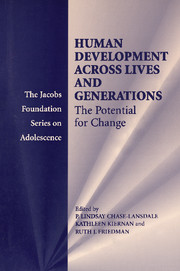Book contents
- Frontmatter
- Contents
- Figures and Tables page
- Contributors
- Foreword
- Acknowledgments
- HUMAN DEVELOPMENT ACROSS LIVES AND GENERATIONS
- Part I Introduction and Overview
- Part II Human Capital
- Part III Partnership Behavior
- 6 Cohabitation and Divorce across Nations and Generations
- 7 The Intergenerational Transmission of Couplelnstability
- 8 Strengthening Partnerships and Families
- Part IV Psychological Health and Development
- Part V Conclusion
- Index
7 - The Intergenerational Transmission of Couplelnstability
from Part III - Partnership Behavior
Published online by Cambridge University Press: 12 October 2018
- Frontmatter
- Contents
- Figures and Tables page
- Contributors
- Foreword
- Acknowledgments
- HUMAN DEVELOPMENT ACROSS LIVES AND GENERATIONS
- Part I Introduction and Overview
- Part II Human Capital
- Part III Partnership Behavior
- 6 Cohabitation and Divorce across Nations and Generations
- 7 The Intergenerational Transmission of Couplelnstability
- 8 Strengthening Partnerships and Families
- Part IV Psychological Health and Development
- Part V Conclusion
- Index
Summary
There is considerable research evidence that offspring of divorced parents are at higher risk for marital instability than those from nondivorced parents. This chapter examines factors and processes that contribute to or protect against the intergenerational transmission of divorce. Data from the Virginia Longitudinal Study of Divorce and Remarriage are used to examine the contribution of six sets of risk factors to marital instability. These indude socioeconomic risk, personality risk, parenting risk, problem solving and interactional skills risk, commitment risk, and mate selection risk. The association of family conflict and divorce with different types of marriages and the protection against the intergenerational transmission of marital instability offered by a supportive spouse from a stable family background are also examined.
Introduction
Marriage has become a more optional, less permanent institution in most western industrialized nations, as patterns of sexuality, childbearing, cohabitation, and marriage have become less predictable and closely linked. Many parents and children are going through multiple changes and rearrangements in intimate relations and in family life that affect their life experiences, opportunities, adjustment, and well being. In the United States the so-called breakdown of the family and increase in the divorce rate and single parent families has been decried by the media, politicians, religious groups, and conservative family theorists. This has led to social policies that attempt to preserve and promote marriage.
Although the divorce rate in the United States began to decline after 1980 after more than doubling over the course of the previous three decades, demographers predict that over 45% of American marriages will end in divorce (Teachman, Tedrow, & Crowder, 2000; U.S. Census Bureau, 1998). Most researchers have taken a pathogenic view of divorce and have focused on the Stresses and adverse outcomes associated with marital breakup. However, it should also be recognized that it can offer an escape from an unhappy, abusive, conflictual, or demeaning marriage and the opportunity to build new, more harmonious, fulfilling relationships, and increased personal growth and individuation.
The Adjustment of Offspring from Divorced Families
In order to understand the adjustment of parents and children to marital transitions and family reorganizations, they have to be examined over time.
- Type
- Chapter
- Information
- Human Development across Lives and GenerationsThe Potential for Change, pp. 171 - 203Publisher: Cambridge University PressPrint publication year: 2004
- 8
- Cited by



